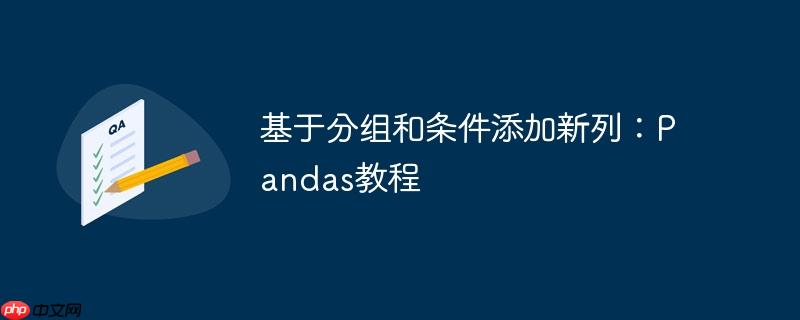
本文详细介绍了如何使用 Pandas 在 DataFrame 中基于分组和条件添加新列。通过 groupby()、apply()、sort_values()、shift() 和 cumsum() 等函数的组合使用,可以实现复杂的数据转换和列生成。本文提供清晰的代码示例和详细的步骤解释,帮助读者理解并掌握该技巧,从而解决实际数据处理中的类似问题。
在数据分析和处理中,经常需要在 Pandas DataFrame 中基于现有列进行分组,并根据分组内的条件计算新列的值。本教程将详细介绍如何使用 Pandas 实现这一目标,并通过一个具体的例子进行说明。
首先,我们创建一个示例 DataFrame,用于演示如何添加新列:
import pandas as pd
import numpy as np
data = {
'id': [1, 2, 3, 4, 5, 6, 7],
'date': ['2019-02-01', '2019-02-10', '2019-02-25', '2019-03-05', '2019-03-16', '2019-04-05', '2019-05-15'],
'date_difference': [None, 9, 15, 11, 10, 19, 40],
'number': [1, 0, 1, 0, 0, 0, 0],
'text': ['A', 'A', 'A', 'A', 'A', 'B', 'B']
}
df = pd.DataFrame(data)
print(df)我们的目标是基于 text 列进行分组,并根据 number 列的值生成一个新的列 test。对于每个分组,test 列的值的计算规则如下:
以下代码展示了如何使用 Pandas 实现上述逻辑:
import pandas as pd
data = {
'id': [1, 2, 3, 4, 5, 6, 7],
'date': ['2019-02-01', '2019-02-10', '2019-02-25', '2019-03-05', '2019-03-16', '2019-04-05', '2019-05-15'],
'date_difference': [None, 9, 15, 11, 10, 19, 40],
'number': [1, 0, 1, 0, 0, 0, 0],
'text': ['A', 'A', 'A', 'A', 'A', 'B', 'B']
}
df = pd.DataFrame(data)
out = df.assign(
# We assign the following values to the series name "test"
test=df
# Group on "text" -- if we grouped on ["text", "number"] we wouldn't see different numbers within the groups.
.groupby("text")
# Apply a chain of methods to the group (a pd.DataFrame).
.apply(
lambda g: (
# We sort "date" in descending order as you mention this partially controls the step size.
g.sort_values(by="date", ascending=False)
# We shift "number" forward one period with a fill_value of 1 for any newly introduced nulls.
.number.shift(periods=1, fill_value=1)
# Cumulatively sum the shifted "number" values
.cumsum()
)
# This will result in the new series, albeit sorted by descending "date".
)
# Drop the "text" level of the new multi-index.
.droplevel("text")
# The assign method acts as join, rearranging the newly created series to match the index of `df`.
)
print(out)代码解释:
本教程介绍了如何使用 Pandas 在 DataFrame 中基于分组和条件添加新列。通过 groupby()、apply()、sort_values()、shift() 和 cumsum() 等函数的组合使用,可以灵活地实现复杂的数据转换和列生成。理解并掌握这些技巧,可以帮助您更高效地进行数据分析和处理。
注意事项:
以上就是基于分组和条件添加新列:Pandas教程的详细内容,更多请关注php中文网其它相关文章!

每个人都需要一台速度更快、更稳定的 PC。随着时间的推移,垃圾文件、旧注册表数据和不必要的后台进程会占用资源并降低性能。幸运的是,许多工具可以让 Windows 保持平稳运行。

Copyright 2014-2025 https://www.php.cn/ All Rights Reserved | php.cn | 湘ICP备2023035733号